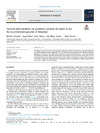Please use this identifier to cite or link to this item:
https://accedacris.ulpgc.es/handle/10553/107973
| DC Field | Value | Language |
|---|---|---|
| dc.contributor.author | Tomasini, Michele | - |
| dc.contributor.author | Duran, Josep | - |
| dc.contributor.author | Simon, Silvia | - |
| dc.contributor.author | Azofra, Luis Miguel | - |
| dc.contributor.author | Poater, Albert | - |
| dc.date.accessioned | 2021-06-21T11:43:59Z | - |
| dc.date.available | 2021-06-21T11:43:59Z | - |
| dc.date.issued | 2021 | - |
| dc.identifier.issn | 2468-8231 | - |
| dc.identifier.other | Scopus | - |
| dc.identifier.uri | https://accedacris.ulpgc.es/handle/10553/107973 | - |
| dc.description.abstract | The Milstein's reported discovery of hydrogenation of thioesters directly toward thiols and alcohols catalyzed by a Ru-acridine complex has been studied here by DFT calculations to know the origin of the different performance depending on the nature of the substituents. Unveiling the reaction mechanism leads to a deeper understanding of the steric and electronic properties on the nature of the limiting step of the reaction. Steric maps and Conceptual DFT have been the tools to rationalize the reactivity patterns. In addition, the nature of the catalyst has been studied, replacing the substituents on the phosphorous atoms by less sterically demanding groups with the aim to move to milder reaction conditions. | - |
| dc.language | eng | - |
| dc.relation.ispartof | Molecular Catalysis | - |
| dc.source | Molecular Catalysis [ISSN 2468-8231], v. 510, 111692 (junio 2021) | - |
| dc.subject | 221001 Catálisis | - |
| dc.subject.other | Homogeneous catalysis | - |
| dc.subject.other | Ruthenium catalysis | - |
| dc.subject.other | Thioesters | - |
| dc.subject.other | Reaction mechanisms | - |
| dc.subject.other | Density functional theory (DFT) | - |
| dc.title | Towards mild conditions by predictive catalysis via sterics in the Ru-catalyzed hydrogenation of thioesters | - |
| dc.type | info:eu-repo/semantics/article | - |
| dc.type | Article | - |
| dc.identifier.doi | 10.1016/j.mcat.2021.111692 | - |
| dc.identifier.scopus | 85109080117 | - |
| dc.contributor.orcid | 0000-0002-1366-1401 | - |
| dc.contributor.orcid | NO DATA | - |
| dc.contributor.orcid | 0000-0003-4935-1824 | - |
| dc.contributor.orcid | 0000-0003-4974-1670 | - |
| dc.contributor.orcid | 0000-0002-8997-2599 | - |
| dc.contributor.authorscopusid | 57224104751 | - |
| dc.contributor.authorscopusid | 7101940910 | - |
| dc.contributor.authorscopusid | 56278173200 | - |
| dc.contributor.authorscopusid | 55142490200 | - |
| dc.contributor.authorscopusid | 8533443400 | - |
| dc.relation.volume | 510 | - |
| dc.investigacion | Ciencias | - |
| dc.type2 | Artículo | - |
| dc.description.numberofpages | 6 | - |
| dc.utils.revision | Sí | - |
| dc.date.coverdate | Junio 2021 | - |
| dc.identifier.ulpgc | Sí | - |
| dc.contributor.buulpgc | BU-BAS | - |
| dc.description.sjr | 0,789 | |
| dc.description.jcr | 5,089 | |
| dc.description.sjrq | Q1 | |
| dc.description.jcrq | Q2 | |
| dc.description.scie | SCIE | |
| dc.description.miaricds | 10,1 | |
| item.fulltext | Con texto completo | - |
| item.grantfulltext | open | - |
| crisitem.author.dept | GIR IUNAT: Fotocatálisis y espectroscopía para aplicaciones medioambientales. | - |
| crisitem.author.dept | IU de Estudios Ambientales y Recursos Naturales | - |
| crisitem.author.orcid | 0000-0003-4974-1670 | - |
| crisitem.author.parentorg | IU de Estudios Ambientales y Recursos Naturales | - |
| crisitem.author.fullName | Azofra Mesa, Luis Miguel | - |
| Appears in Collections: | Artículos | |
SCOPUSTM
Citations
16
checked on Jun 8, 2025
WEB OF SCIENCETM
Citations
19
checked on Jun 8, 2025
Page view(s)
175
checked on Feb 22, 2025
Download(s)
151
checked on Feb 22, 2025
Google ScholarTM
Check
Altmetric
Share
Export metadata
Items in accedaCRIS are protected by copyright, with all rights reserved, unless otherwise indicated.
